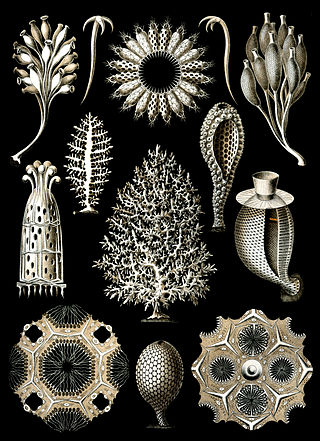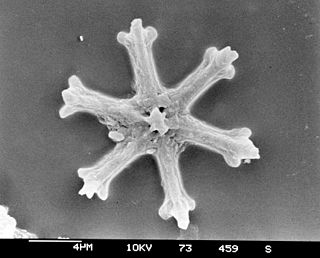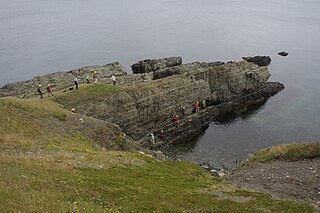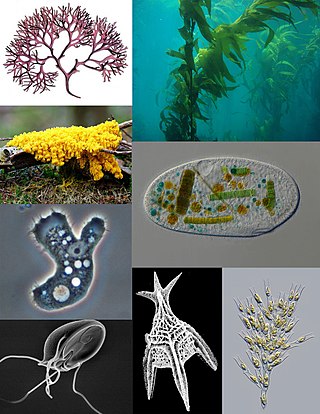Related Research Articles

The Burgess Shale is a fossil-bearing deposit exposed in the Canadian Rockies of British Columbia, Canada. It is famous for the exceptional preservation of the soft parts of its fossils. At 508 million years old, it is one of the earliest fossil beds containing soft-part imprints.

The Cambrian Period is the first geological period of the Paleozoic Era, and of the Phanerozoic Eon. The Cambrian lasted 53.4 million years from the end of the preceding Ediacaran Period 538.8 million years ago (mya) to the beginning of the Ordovician Period 485.4 mya. Its subdivisions, and its base, are somewhat in flux.

The Ediacaran period is a geological period of the Neoproterozoic era that spans 96 million years from the end of the Cryogenian period at 635 Mya, to the beginning of the Cambrian period at 538.8 Mya. It is the last period of the Proterozoic eon as well as the last of the so-called "Precambrian supereon", before the beginning of the subsequent Cambrian period marks the start of the Phanerozoic eon where recognizable fossil evidence of life becomes common.

A reef is a ridge or shoal of rock, coral or similar relatively stable material, lying beneath the surface of a natural body of water. Many reefs result from natural, abiotic (non-living) processes such as deposition of sand or wave erosion planing down rock outcrops. However, reefs such as the coral reefs of tropical waters are formed by biotic (living) processes, dominated by corals and coralline algae. Artificial reefs such as shipwrecks and other man-made underwater structures may occur intentionally or as the result of an accident, and are sometimes designed to increase the physical complexity of featureless sand bottoms to attract a more diverse range of organisms. Reefs are often quite near to the surface, but not all definitions require this.

The calcareoussponges are members of the animal phylum Porifera, the cellular sponges. They are characterized by spicules made of calcium carbonate, in the form of high-magnesium calcite or aragonite. While the spicules in most species are triradiate, some species may possess two- or four-pointed spicules. Unlike other sponges, calcareans lack microscleres, tiny spicules which reinforce the flesh. In addition, their spicules develop from the outside-in, mineralizing within a hollow organic sheath.

A microfossil is a fossil that is generally between 0.001 mm and 1 mm in size, the visual study of which requires the use of light or electron microscopy. A fossil which can be studied with the naked eye or low-powered magnification, such as a hand lens, is referred to as a macrofossil.

Coralline algae are red algae in the order Corallinales. They are characterized by a thallus that is hard because of calcareous deposits contained within the cell walls. The colors of these algae are most typically pink, or some other shade of red, but some species can be purple, yellow, blue, white, or gray-green. Coralline algae play an important role in the ecology of coral reefs. Sea urchins, parrot fish, and limpets and chitons feed on coralline algae. In the temperate Mediterranean Sea, coralline algae are the main builders of a typical algal reef, the Coralligène ("coralligenous"). Many are typically encrusting and rock-like, found in marine waters all over the world. Only one species lives in freshwater. Unattached specimens may form relatively smooth compact balls to warty or fruticose thalli.
The Cambrian explosion, Cambrian radiation,Cambrian diversification, or the Biological Big Bang refers to an interval of time approximately 538.8 million years ago in the Cambrian Period of early Paleozoic when there was a sudden radiation of complex life and practically all major animal phyla started appearing in the fossil record. It lasted for about 13 – 25 million years and resulted in the divergence of most modern metazoan phyla. The event was accompanied by major diversification in other groups of organisms as well.

Discoaster is a genus of extinct star-shaped marine algae, with calcareous exoskeletons of between 5-40 μm across that are abundant as nanofossils in tropical deep-ocean deposits of Neogene age. Discoaster belongs to the haptophytes. About 100 species can be recognized.

Anabarites is a problematic lower Cambrian genus, and is one of the small shelly fossils. It was abundant in the early Tommotian and is also found in the Nemakit-Daldynian. The fossils represent the triradially symmetrical mineralised tube in which the organism dwelt; it was sedentary. It is named after the Anabar region in Yakutia, Russia; its name does not imply 'heavy'.
Girvanella is a fossil thought to represent the calcified sheath of a filamentous cyanobacterium known from the Burgess Shale and other Cambrian fossil deposits.

Salterella is an enigmatic Cambrian genus with a small, conical, calcareous shell that appears to be septate, but is rather filled with stratified laminar deposits. The shell contains grains of sediment, which are obtained selectively by a manner also observed in foramanifera. The genus was established by Elkanah Billings in 1861, and was named after the English palaeontologist John William Salter.

The anabaritids or angustiochreids are enigmatic tubular, mineralizing organisms with a trifold symmetry known from their Lower Cambrian fossils. They may have represented cnidaria, but their affinity within the Metazoa is difficult to constrain.

The Terreneuvian is the lowermost and oldest series of the Cambrian geological system. Its base is defined by the first appearance datum of the trace fossil Treptichnus pedum around 538.8 million years ago. Its top is defined as the first appearance of trilobites in the stratigraphic record around 521 million years ago. This series' name was formally accepted by the International Commission on Stratigraphy in 2007.

Delgadella is a diminutive trilobite that lived during the late Lower Cambrian and has been found in Russia, Mongolia, Spain, Italy (Sardinia), Portugal, Morocco and Canada (Newfoundland). It can be recognized by its strongly effaced headshield and tailshield, with narrow but distinct furrows and borders along its margins, and three thorax segments.
Proaulopora is a Cambrian–Ordovician fossil genus of calcareous algae. It has been variously thought to belong to the green algae, red algae or cyanobacteria. It was originally established by the Russian paleontologist Aleksandr Grigoryevich Vologdin in 1937, for species known from the Lower Cambrian of the western Altai Mountains.
Oktyabrina Vladimirovna Voronova was the first Soviet poet of Sámi origin to write a poetry collection in a Sámi language in Russia. Voronova wrote in both Russian and Sámi. She was living in Revda at the time of her death.

A protist is any eukaryotic organism that is not an animal, plant, or fungus. While it is likely that protists share a common ancestor, the last eukaryotic common ancestor, the exclusion of other eukaryotes means that protists do not form a natural group, or clade. Therefore, some protists may be more closely related to animals, plants, or fungi than they are to other protists. However, like algae, invertebrates and protozoans, the grouping is used for convenience.
Eugonophyllum is a genus of green algae in the family Halimedaceae. Specimens have been found in Carboniferous to Permian beds in North America, Europe, and east Asia.
References
- ↑ Voronova, L. G. (1976). Известковые водоросли пограничных слоев докембрия и кембрия сибирской платформы[Calcareous algae of the Precambrian-Cambrian boundary deposits of the Siberian platform]. In Voronova, L. G.; Radionova, E. P. (eds.). Водоросли и микрофитолиты палеозоя [Paleozoic algae and microphytolites](PDF) (in Russian). Moscow: USSR Academy of Sciences. pp. 3–85, 156–183, 212–214.
- ↑ Luchinina, V. A. (2009). "Remalcis and Epiphyton as different stages in the life cycle of calcareous algae". Paleontological Journal. 43 (4): 463–468. Bibcode:2009PalJ...43..463L. doi:10.1134/S0031030109040169. S2CID 85094645.